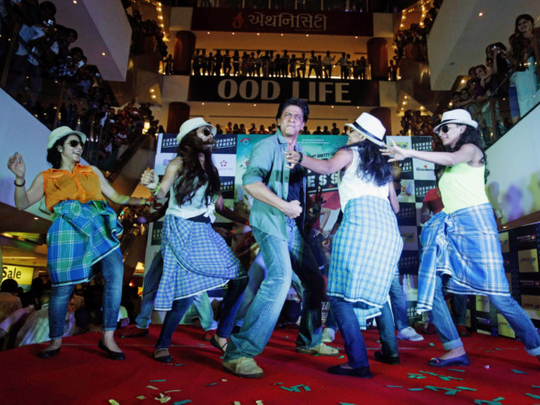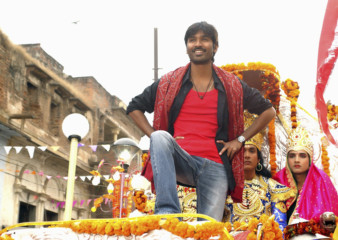
Blame it on Mehmood and Padosan. Some 45 years ago, when the comedian, playing music teacher Pillai aka Masterji in the film, hiked his veshti (loincloth), wiggled his kudmi (ponytail) and trilled, “Baabbyy” to a simpering Saira Banu, he created a Southern stereotype that remains one of the cheapest ways of raising a laugh in Hindi films.
If it’s a Tamilian man, wrap him up in a lungi, slap on that accent and roll out the idlis. For a girl, yank out a Bharatanatyam costume, pile a mound of jasmine flowers on her head and make her exclaim “Aiyaiyo!” whether she’s sad, ecstatic or romantic.
Chennai Express
The most recent perpetrator of this cultural crime is Chennai Express, in which Deepika Padukone’s accent switches inexplicably from a strong Malayali one to a Tamilian one. To quote from her unique dictionary in the movie, where do these guys get this “bakwos” from? When Shahrukh Khan playing the geeky Shekhar Subramaniam, did that offensive curds-and-noodles act in Ra One, we asked ourselves, how did one of our smartest stars ever perpetrate this travesty? And how long will Bollywood peddle these grotesque caricatures?
The good news, notwithstanding Chennai Express, is: not for too long hopefully. There are signs of change: Dhanush in Raanjhanaa, Prithviraj in Aiyyaa and Abhay Deol in Shanghai, to name some of the front runners.
Of course, there has always been the odd film that did not stoop to cultural pigeonholing, that knew better than to label any South Indian character a ‘Madrasi’. Mahesh Bhatt’s Hum Hain Rahi Pyaar Ke and Mohanlal’s turn in Ram Gopal Varma’s Company come to mind, as does K. Balachander’s Ek Duuje Ke Liye, in which Kamal Haasan’s ethnicity was used legitimately. Of course, there was Aparna Sen’s Mr and Mrs Iyer, but that was not exactly mainstream. Mani Ratnam’s Roja and Bombay were pitch-perfect too, but then, you would expect no less from him as a director and a Tamilian at that. However, these films were exceptions amid the caricatures.
So the delineation of Dhanush’s role in Raanjhanaa as Kundan Shankar, the South Indian boy who grew up in Varanasi, comes as sweet relief. Interestingly, director Aanand L. Rai reveals that the original story did not have Kundan as a Tamilian. “I was searching for a certain kind of unconventional actor and I saw him in Dhanush,” recounts Rai. “So we went looking for someone like him in Bollywood, but nobody there was ready to play this character. One day I said to myself, the only problem with Dhanush is his Hindi. I could get him to kill his accent, but how would that help? Why make him play the typical Bollywood actor when he should be playing the character?”
And that’s how Kundan became a Tamilian, with his ethnicity reflected in his natural accent, but not becoming an overriding factor in the story, and definitely without any cultural stereotyping. That Raanjhanaa was a big hit clearly shows that the audience approves and is ready for change.
Authencity is key
As Mahesh Bhatt observes, “Earlier, Hindi cinema looked at south Indian as the other and that was obvious in its depictions.”
But now, he notes, the audience demands greater authenticity from film-makers. “My daughter (Alia Bhatt), who’s playing a South Indian girl in her next film (an adaptation of Chetan Bhagat’s 2 States), has been give a proper teacher who’s taught her chaste Tamil and encouraged a genuine engagement with the culture,” he says.
For his own Hum Hain Rahi Pyar Ke, way back in 1993, Bhatt says, “We did not want to make a caricature of Vaijayanti Iyer [played by Juhi Chawla] and her father. In fact, Mr Iyer was played by K.D. Chandran, who was not a professional actor; he was a very well-educated officer in the USIS. We wanted him to bring the right body language and a certain innocence to the character. We tried to be as real as possible within the matrix of popular Hindi cinema.”
Director-writer Sachin Kundalkar went a step further when he needed an actor for the role of Surya, a Tamil artist in Aiyyaa. He didn’t want “a conventional Punjabi hero faking a south Indian accent.” What he wanted was “an actor who could play a very quiet character, and who has powerful eyes, because they had to do most of the talking.” When he met South actor Prithivraj, he says, “I knew he was perfect for the role. I loved his quiet sophistication as a person and actor.” > Kundalkar adds, “I have many South Indian friends like that, and what I admire most about them is that it’s always about the person inside, not the exterior. And I felt I had a responsibility to depict that correctly.”
A quiet core was also a key note in Abhay Deol’s take on T.A. Krishan, the IAS officer in Dibakar Banerjee’s Shanghai. Deol spent months getting his accent right, taking care to use it only in certain words. The result was a nuanced depiction that was much applauded.
However, Kundalkar points out, “Bollywood is a space that does not appreciate subtle regional textures. It confines itself to being Hindi cinema and is too timid to attempt to be national cinema. It doesn’t speak to half our country; it never addresses that world except in stereotypes.”
Not enough research
But then, Bollywood stereotypes most communities. Punjabis drown in puttars and lassi and launch into a balle balle at the drop of a turban (even the sensitive Imtiaz Ali succumbed in Jab We Met), Bengalis traipse around old havelis and go “Bhalo, bhalo” (good, good), (or “Eeeesssh!” if it’s Aishwarya Rai in Devdas). A Durga puja is always round the corner in Bengal and Ganpati celebrations in Mumbai. Christians waltz off to church all the time, where a syrupy father will intone, “Welcome, my son.” If there’s a Muslim, there’s got to be a taveez or a qawali somewhere.
“The problem is that research and Hindi cinema do not have a long relationship. Hindi cinema is based on the memory of caricatures, in which people are reduced to stereotypes,” observes Bhatt.
However, he adds, “It has to be said that there is no such thing as a ‘typical’ Tamilian or Punjabi or whoever. Typical does not exist, but it is the tendency of the human mind to reduce people to stereotypes. We in the film industry suffer it, too, in the eyes of society and especially the political class, who see us as a stereotype. I want to say to them, “We are not depraved individuals, we are as concerned about the world as you are because we live in it and our children live in it.”
That clearly hurts, Mr Bhatt. We understand. But don’t look for sympathy south of the Vindhyas.







